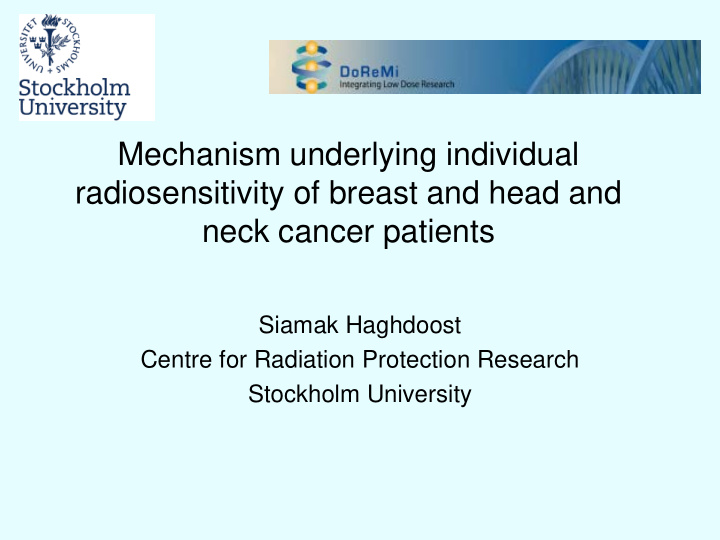



Mechanism underlying individual radiosensitivity of breast and head and neck cancer patients Siamak Haghdoost Centre for Radiation Protection Research Stockholm University
WP6 DoReMi Individual variability in susceptibility to cancer (WP 6)
The overall objectives for WP6 are • To provide the experimental evidence to incorporate the influence of genetic modifiers, age and gender on cancer risk ,at low doses and low dose rates, to radiation protection practices • To coordinate activities with cross-workpackage programs in molecular epidemiology, dosimetry and systems biology. • To integrate WP6 research with activities from national and EURATOM sponsored research into the HLEG roadmap through the preparation of open calls for scientific projects
Description of WP6 tasks Task 6.1 Molecular epidemiological studies to address the role of individual genetic variation in determining susceptibility to low doses (Starting Year 1). Task 6.2 Identification of genetic modifiers of individual cancer susceptibility and their mechanisms of action Task 6.3 Modelling of the effects on risk prediction models due to changes in biological processes influenced by genetic variability Task 6.4 The effect of genetic modifiers on carcinogenesis following low dose rate exposure Task 6.5 Contribution of genetic and epigenetic mechanisms that indirectly influence susceptibility to radiation-induced cancer Xxxx Task 6.11: RADSENS
Task 6.8 Poster 2-PS2D-12 (Tuesday, May 26 th ) Investigation of radiosensitivity in healthy controls, AT patients and prostate cancer patients. Presenter: Lisa White Poster 4-PS1B-52 (Thursday May 28 th ) Low dose effects in peripheral blood lymphocytes with Raman spectroscopy. Presenter: Dr Jane Bryant
Aims of Radsens: • What pathways triggered by low dose radiation (mGy range) • What pathways differing sensitive/non sensitive patients Longterm aim: • To have predictive assay to be able to distinguish between extreme sensitive normal normal senstive patients Cohorts?
Ex. Osteoradionecrosis Ex. Severe skin reaction Bernett, G, et. al. 2009
Mechanistical studies Experimental design MicroRNA Validation of candidate biomarkers in an extended cohort of patients > 200 patients
Breast cancer cohort Total 2914 patients S Skiöld et.al. 2013 Mut. Res. 30; 756 (1-2): 152-7 2015-06-05 0-1 2 3 4
Head and neck cancer cohort The incidence for ORN is ~5% It is a late adverse effect to radiotherapy occurring 1-10 years after the end of the treatment. There are ~280 new cases/year of head and neck cancer in Stockholm, Sweden Available: 37 patients with osteoradionecrosis (ORN) and 37 matched controls.
Urinary excretion of 8-oxo-dG in breast cancer patients before start of radiotherapy 40 Radiosensitive group: Urinary 8-oxo-dG 35 (ng/8 hrs/kg) 30 High background levels and 25 low therapy related increase 20 15 of urinary 8-oxo-dG 10 5 0 Normalized to BMI Not normalized to BMI radiosensitive P < 0.05 radioresistant Relative changes of urinary excretion of 8-oxo-dG in breast cancer patients during radiotherapy Non-sensitive group: 2700 2700 Low background levels and Uninary 8-oxo-dG (% ) 2200 2200 high therapy related increase 1700 1700 1200 1200 of urinary 8-oxo-dG 700 700 200 200 -300 -300 22 12 radioresistant Dose (Gy) P < 0.001 radiosensitive Intl. J. of Radiation Oncology, Biology, Physics, 2001
Radiosensitive Skiöld, S. et. al. Mut. Res. 2013.
Collaboration with Dr. Soile Tapio, Germany
Pooled samples Normo-sensitive patients Radiosensitive patients 8-oxo-dG level SOD1 BLVRB CA1 PRDX2 PARK7 PRDX2 SH3BGRL3
1 mGy gamma radiation affects several protein expression in cells from normosensitive related to: • Oxidative stress / NRF2-mediated oxidative stress response, • Decreased transmembrane potential of mitochondria and mitochondrial membrane Unique proteomic signature for radiation sensitive patients; a comparative study between normo-sensitive and radiation sensitive breast cancer patients Sara Skiöld a Omid Azimzadeh b, Juliane Merl-Pham c Ingemar Naslund d , Peter Wersall d , Elisabet Lidbrink d , Soile Tapio b ,Mats Harms-Ringdahl a , Siamak Haghdoost a, Mutation Research. 2014,
Oxidative stress DNA repair Inflammation XRCC3 (2) OGG1 (1) HIF1A (5) NOS3/eNOS (1) APEX1 (1) TGFB (2) ATM (6) RAD21 (1) XPC (2) GSTP1 (1) RAD9A (2) NFE2L2 (1) IL12RB2 (1) RAD17 (1) VEGFA (7) Catalase (1) MTH1/NUDT1 (1) GSTA1 TP53 (1) SOD2a XRCC1 (2) ? ? ? Individual radosensitivity/ORN Investigating 58 point mutations (SNPs) previously implicated in side effects to RT
Danielsson, D. et. al. 2014, head and neck
miRNAs as biomarker for individual radiosensitivity (RADSENS) RTGO 0 RTGO 3 miRnome analysis:1152 miRNAs sample in vitro 1 mGy irradiation RTOG 3/ RTGO 0 20 down, 11 up 150 mGy (whole blood) RTOG 3, 150 mGy 23 down, 24 up RTOG 0, 150 mGy 18 down, 15 up RTOG 3, 1 mGy 61 up miRNA expression RTOG 0, 1 mGy 41 down, 24 up (lymphocytes)
miRNA expression changes after low dose irradiation
General conclusion • Patients individual ability to handle oxidative is related to individial respose to radiotherapy • miRNA biomarkers: validation is ongoing in cellular model system using miRNA inhibitors • Oxidative stress response, coagulation properties and acute phase response are hallmarks of radiation sensitivity supporting our previous study on oxidative stress response. - 8-oxo-dG levels - protemic approache - SNP in GSTP1
CRPR, Stockholm University Dr. Soile Tapio Dr. Simone Mörtl
Recommend
More recommend